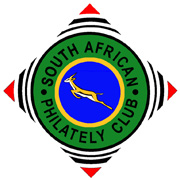Flags & Heraldry of SA
Quote from Steve on September 2, 2025, 6:31 pmI created this page below for my 'UDF Invasion of GSWA' display because I was unsure which flag Prime Minister General Louis Botha raised over Windhuk. A weekend ago I found the postcard bottom below at a postcard fair in Bury St Edmunds and it reignited my interest in this subject. Please feel free to comment and also add any relevant images that you have. Thanks.
One of the two Red Ensign flags above were presumably used by Botha in Windhoek, likely the RHS one.
Below is the postcard that I recently found. As you will see it is similar but slightly different to the blue version of the one described above. This new one lacks the white circle.
Postcard.
Circa 1910 -1912. Postcard. The Union of South Africa. (The Milton Post Card).
The Milton 'TOPICAL' Series. No. 19. Woolstone Bros. London EC. All British.Further to the statement, "Following Admiralty approval, Blue and Red Ensign flags bearing the Union of South Africa coat of arms were used as the South African flag between 1910 - 1928. A Red Ensign bearing the Union’s coat of arms in a shield was discontinued in 1912 ...." the above presumably shows the Blue Ensign "bearing the Union of South Africa coat of arms" discontinued in 1912.
This card describes the Union of South Africa. "Total area, 473,100 square miles. Population about 6 millions, of which 1.25 million are of European origin. The form of governement is a Union of self-governing colonies" (as seen in the coat of arms).
I created this page below for my 'UDF Invasion of GSWA' display because I was unsure which flag Prime Minister General Louis Botha raised over Windhuk. A weekend ago I found the postcard bottom below at a postcard fair in Bury St Edmunds and it reignited my interest in this subject. Please feel free to comment and also add any relevant images that you have. Thanks.

One of the two Red Ensign flags above were presumably used by Botha in Windhoek, likely the RHS one.
Below is the postcard that I recently found. As you will see it is similar but slightly different to the blue version of the one described above. This new one lacks the white circle.
Postcard.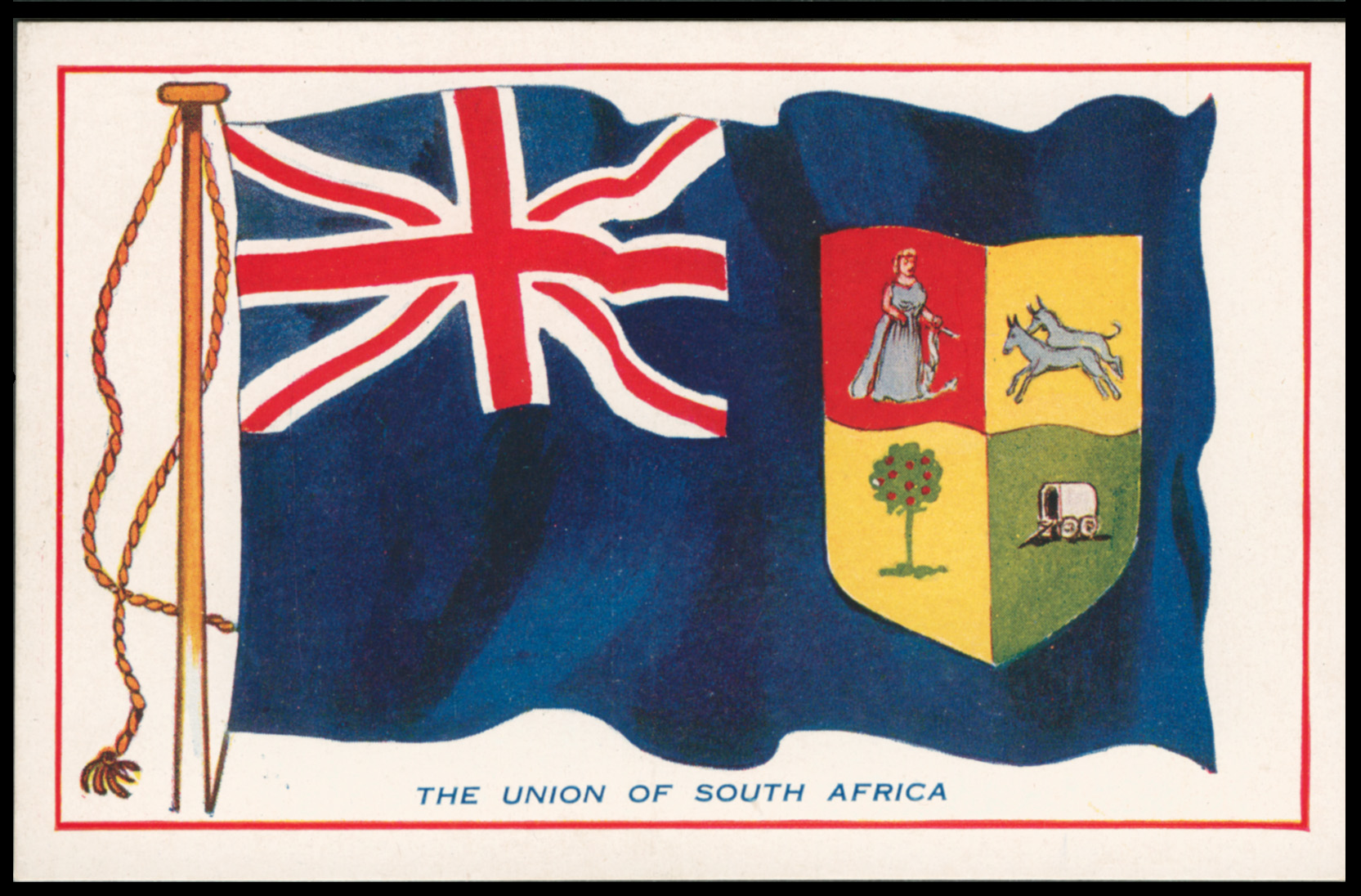
Circa 1910 -1912. Postcard. The Union of South Africa. (The Milton Post Card).
The Milton 'TOPICAL' Series. No. 19. Woolstone Bros. London EC. All British.
Further to the statement, "Following Admiralty approval, Blue and Red Ensign flags bearing the Union of South Africa coat of arms were used as the South African flag between 1910 - 1928. A Red Ensign bearing the Union’s coat of arms in a shield was discontinued in 1912 ...." the above presumably shows the Blue Ensign "bearing the Union of South Africa coat of arms" discontinued in 1912.
This card describes the Union of South Africa. "Total area, 473,100 square miles. Population about 6 millions, of which 1.25 million are of European origin. The form of governement is a Union of self-governing colonies" (as seen in the coat of arms).
Quote from Steve on September 2, 2025, 6:46 pmThe Union Jack arrived in SA with the First British Occupation of the Cape in 1795, left in 1803 and returned in 1806 and remained presumably until the Union became a Republic in 1961.
The embellished postcard above shows the Union Jack as the 'official' flag of South Africa and the Empire after 1910. A Loyal imperialist serving in the UDF has obtained a German postcard and defaced it with a Union Jack following Botha's victory. This was not uncommon. As a bonus in a heraldic display this card shows a very nice example of the authority of the Kaiser in GSWA with its Imperial German Eagle.
Flags were and still are for most people and nations very important national symbols of pride and history.
I have recently inserted the following item found in a stamp album after I had 'finished' this page. It has some relevance to GSWA / SWA. What is curious about this label is that it shows South Africa after 1919 when Germany lost its GSWA colony and it became a mandated territory run by South Africa. This label includes a representation of what the Germans thought was a imperial British flag.
Circa 1920. "The British Union of South Africa'.
It describes today's Namibia as 'Once German SWA' and in red 'since 1919 Brit.'
I think I will include this in my SWA display!
The Union Jack arrived in SA with the First British Occupation of the Cape in 1795, left in 1803 and returned in 1806 and remained presumably until the Union became a Republic in 1961.
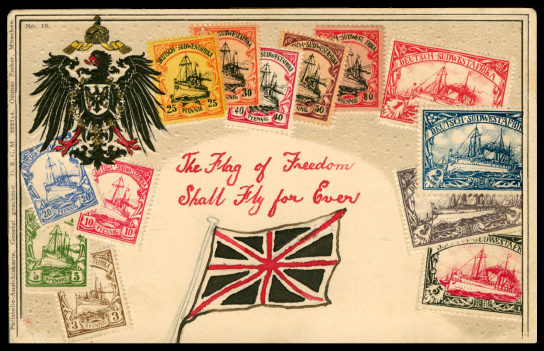
The embellished postcard above shows the Union Jack as the 'official' flag of South Africa and the Empire after 1910. A Loyal imperialist serving in the UDF has obtained a German postcard and defaced it with a Union Jack following Botha's victory. This was not uncommon. As a bonus in a heraldic display this card shows a very nice example of the authority of the Kaiser in GSWA with its Imperial German Eagle.
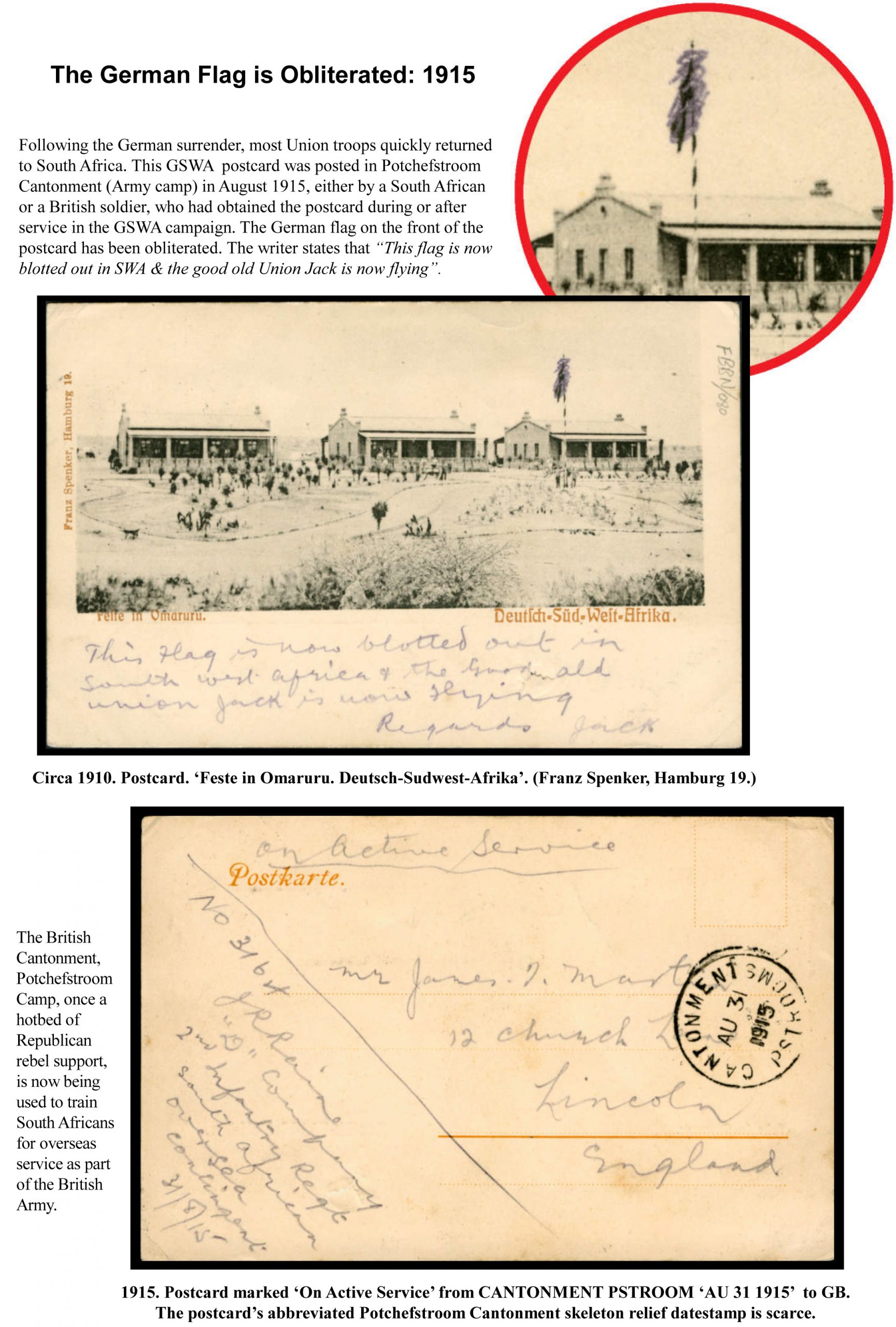
Flags were and still are for most people and nations very important national symbols of pride and history.
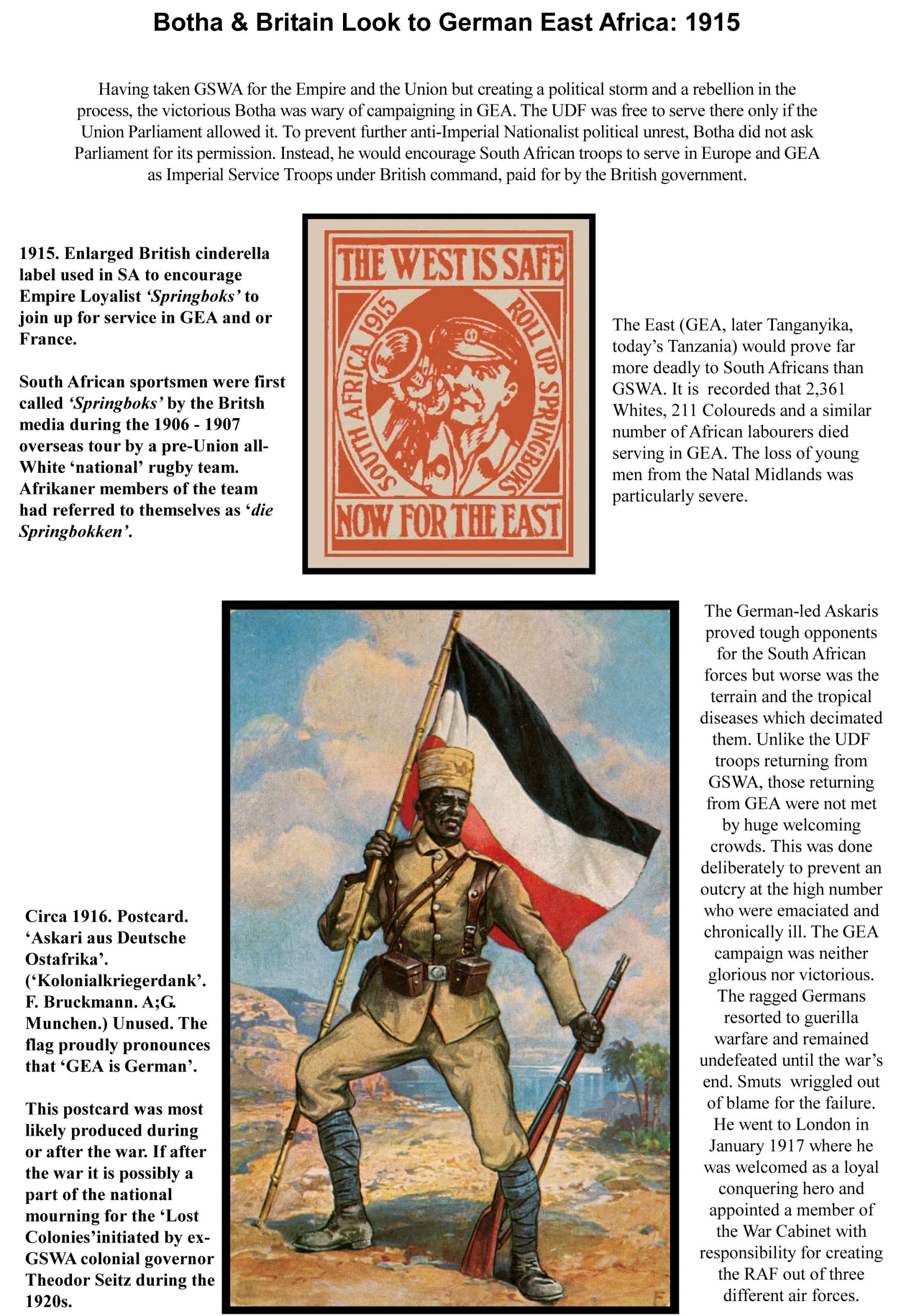
I have recently inserted the following item found in a stamp album after I had 'finished' this page. It has some relevance to GSWA / SWA. What is curious about this label is that it shows South Africa after 1919 when Germany lost its GSWA colony and it became a mandated territory run by South Africa. This label includes a representation of what the Germans thought was a imperial British flag.
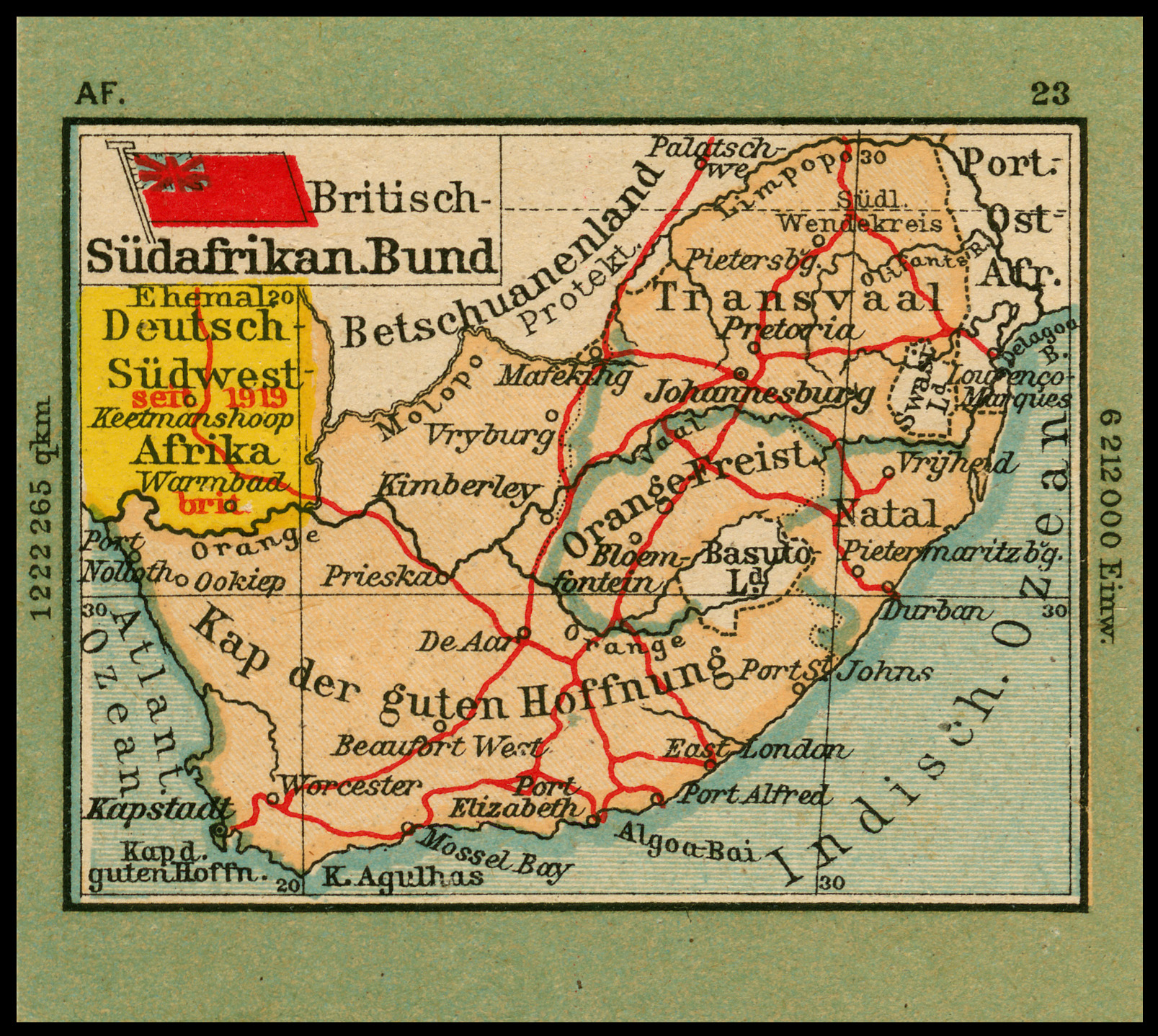
Circa 1920. "The British Union of South Africa'.
It describes today's Namibia as 'Once German SWA' and in red 'since 1919 Brit.'
I think I will include this in my SWA display!
Quote from Jamie Smith on September 2, 2025, 8:26 pmInteresting. Thanks for the hard work.
Interesting. Thanks for the hard work.
Quote from Steve on September 4, 2025, 10:17 amHere is one for the British Empire. This is a common postcard from the start of WW1 that fits in well here, showing as it does the Union Jack, the flag of the Empire, as well as its iconic heraldic British Lion revealing the strength hidden within its mane, Briain's major colonies. When first shown this card I had difficulty seeing CANADA (top) with INDIA, AUSTRALIA, NEW ZEALAND & AFRICAN COLONIES below.
1914. The Glory of a Lion is his Mane. (Copyright.) Boots The Chemists "Patriotic Series".
"A Tribute to Our Colonies" - By William Armitage.The British Empire's zenith came in the late 19th and early 20th centuries when it included Canada, India, Australia, New Zealand, and South Africa, each with distinct colonial trajectories evolving toward self-governance and independence.
The postcard above was produced shortly after Britain entered World War I on 4th August 1914. When Britain went to war its colonies and Dominions were automatically drawn into the conflict as they were under the foreign policy authority of the British government in London. Canada, India, Australia, New Zealand and South Africa were expected to contribute resources, supplies, and soldiers to the war effort. Its colonies made Britain a much more powerful global force than it would have been standing alone.
The British Union Jack, the flag of the Empire.
Britain, (England, Wales, Scotland and Ireland) lost 704,803 servicemen in the First World War It suffered by far the lion's share (no pun intended) of deaths from combat, wounds, disease, injury or men missing in action or at sea. Given the introduction of aerial bombing, submarine warfare and coastal bomnardment, as well as indirect effects like disease and famine exacerbated by the war, the number of British civilian deaths from enemy action in World War I is estimated at around 107,000. Notably, British shells and shrapnel used in defence against German air raids caused as many civilian casualties as enemy bombs.
Canada 1905–1922
A version of the Canadian red ensign defaced with the coat of arms of the Dominion of Canada.
1900. Cover. CANADIAN CONTINGENT SOUTH AFRICA 'MAR 23 1900' to CANADA. (ex. Dr Franks.)
Canada's colonial status began with French cessions in 1763, leading to British North American provinces. In 1867, Confederation formed the Dominion of Canada, granting internal self-rule while foreign affairs remained under British control. The 1931 Statute of Westminster affirmed legislative independence. Full sovereignty came via the 1982 Constitution Act. Canada lost some 65,000 men in WW1.
India was initially exploited by the East India Company from the 1600s. After the 1857 Sepoy Mutiny it fell under direct Crown rule and was known as the British Raj. Indian troops played a significant role in both the First and Second World Wars. Millions of men from the Indian Army fought on various fronts including the Western Front, North Africa, the Middle East, and Southeast Asia, providing a massive fighting force and crucial supplies that were vital to Britain's war efforts. Nationalist movements culminated in independence and the partition of India and Pakistan in 1947. India became a republic in 1950, Pakistan in 1956. Both remained within the Commonwealth.
India (India and Pakistan) lost some 74,ooo men in WW1 and over 87,000 Indian troops in WW2. In both conflicts they served under the Union Jack. The difference between the two wars lay in the 1.5 to 3 million Indian civilians who died in World War II. The civilian death toll in India during World War II was largely the result of the Bengal Famine of 1943 and the strainsplaced on food supply and distribution caused by the war effort. Other contributing factors included bombing, relocation, civil unrest and disease
Australia 1908
A Blue Ensign defaced with the seven-point Commonwealth Star and Southern Cross in the fly half.
Still currently used as the national flag of Australia.Australia's colonisation started with the 1788 penal settlement at Botany Bay, expanding into self-governing colonies. Federation in 1901 established it as a Dominion, with independence formalized in 1931.
New Zealand 1902
A Blue Ensign with the Southern Cross of four white-edged red five-pointed stars in the fly half.
This flag is still currently used as the National flag of New Zealand.New Zealand, annexed in 1840 via the Treaty of Waitangi, gained responsible government in 1852 and Dominion status in 1907, achieving full independence in 1947. Australia lost just over 62,000 men and New Zealand some 18,000 men in WW1.
South Africa 1912
The design of the Red Ensign was modified slightly in 1912 when the shield was placed on a white disc.
The Red Ensign continued to be used as the flag of the South African merchant marine until 1951South Africa's Cape Colony was seized twice, first in 1795 - 1803 and again in 1806 after which it was purchased for £6m as part of the London Convention. an agreement to resolve territorial disputes after Napoleon's defeat. Tensions between the British colonies, the Boer republics and Black South African tribes fueled numerous wars. In 1910 the conquered Boer states of the Orange Free State and South African Republiv (ZAR / Transvaal) joined together to create the Union of South Africa, a British Dominion that exluded Blacks politically. 'White South African' racial policies led to a republican status in 1961 and a temporary exit from Commonwealth until 1994. South Africa lost some 11,700 men of all races in WW1. Rhodesian sources indicate that 700 White settlers and a total of 873 people of all races died in the conflict.
These nations transitioned from imperial subjugation as colonies to full autonomy within the evolving Commonwealth, reflecting decolonisation amid global shifts in power and allegiances.
Here is one for the British Empire. This is a common postcard from the start of WW1 that fits in well here, showing as it does the Union Jack, the flag of the Empire, as well as its iconic heraldic British Lion revealing the strength hidden within its mane, Briain's major colonies. When first shown this card I had difficulty seeing CANADA (top) with INDIA, AUSTRALIA, NEW ZEALAND & AFRICAN COLONIES below.
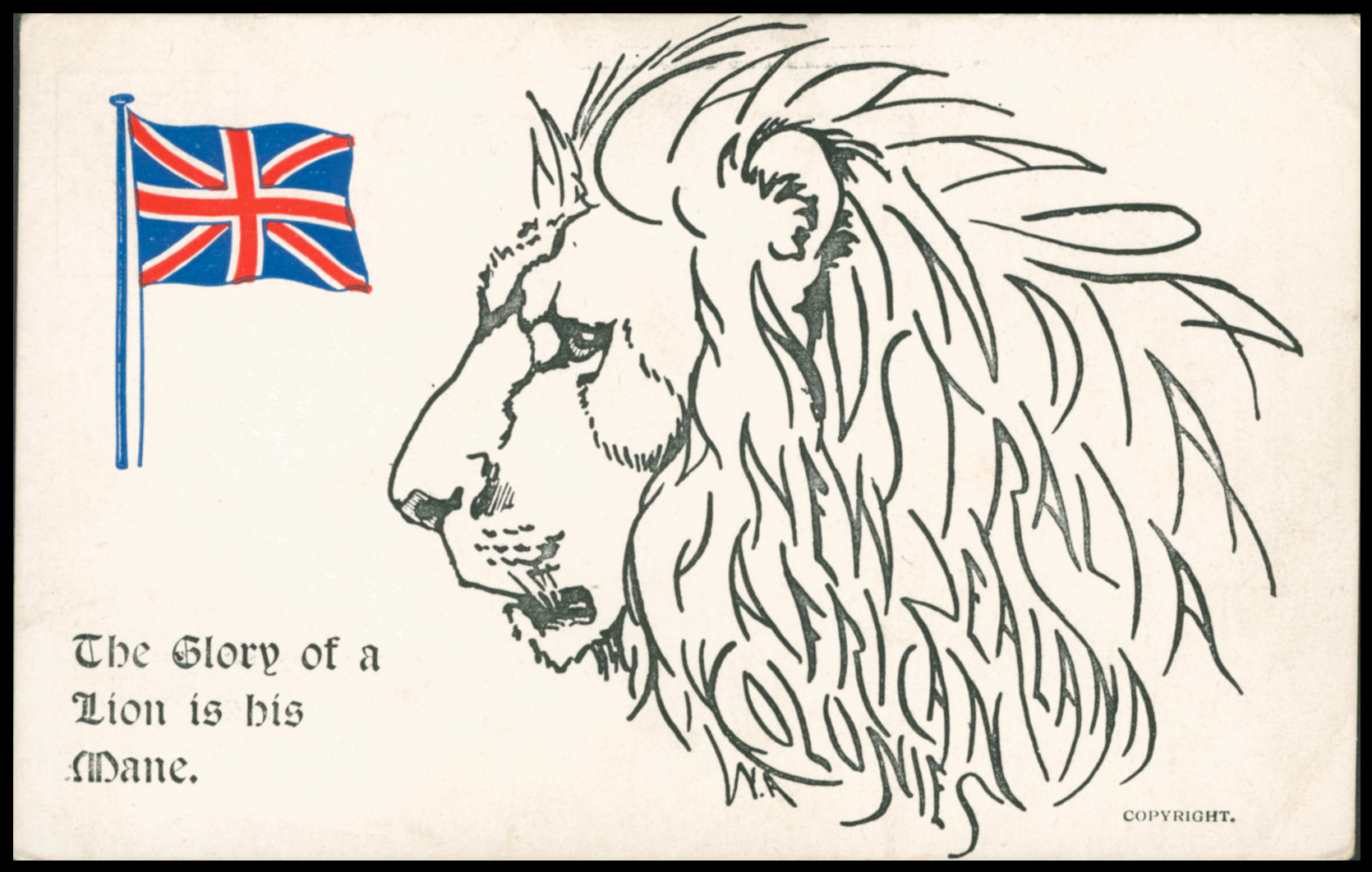
1914. The Glory of a Lion is his Mane. (Copyright.) Boots The Chemists "Patriotic Series".
"A Tribute to Our Colonies" - By William Armitage.
The British Empire's zenith came in the late 19th and early 20th centuries when it included Canada, India, Australia, New Zealand, and South Africa, each with distinct colonial trajectories evolving toward self-governance and independence.
The postcard above was produced shortly after Britain entered World War I on 4th August 1914. When Britain went to war its colonies and Dominions were automatically drawn into the conflict as they were under the foreign policy authority of the British government in London. Canada, India, Australia, New Zealand and South Africa were expected to contribute resources, supplies, and soldiers to the war effort. Its colonies made Britain a much more powerful global force than it would have been standing alone.
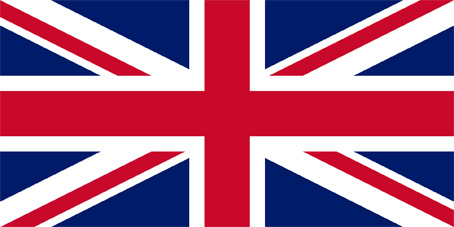
The British Union Jack, the flag of the Empire.
Britain, (England, Wales, Scotland and Ireland) lost 704,803 servicemen in the First World War It suffered by far the lion's share (no pun intended) of deaths from combat, wounds, disease, injury or men missing in action or at sea. Given the introduction of aerial bombing, submarine warfare and coastal bomnardment, as well as indirect effects like disease and famine exacerbated by the war, the number of British civilian deaths from enemy action in World War I is estimated at around 107,000. Notably, British shells and shrapnel used in defence against German air raids caused as many civilian casualties as enemy bombs.
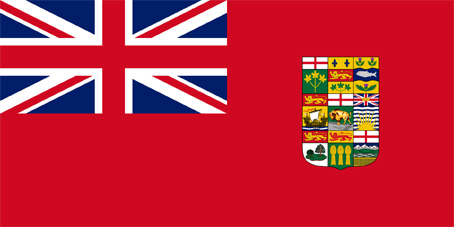
Canada 1905–1922
A version of the Canadian red ensign defaced with the coat of arms of the Dominion of Canada.
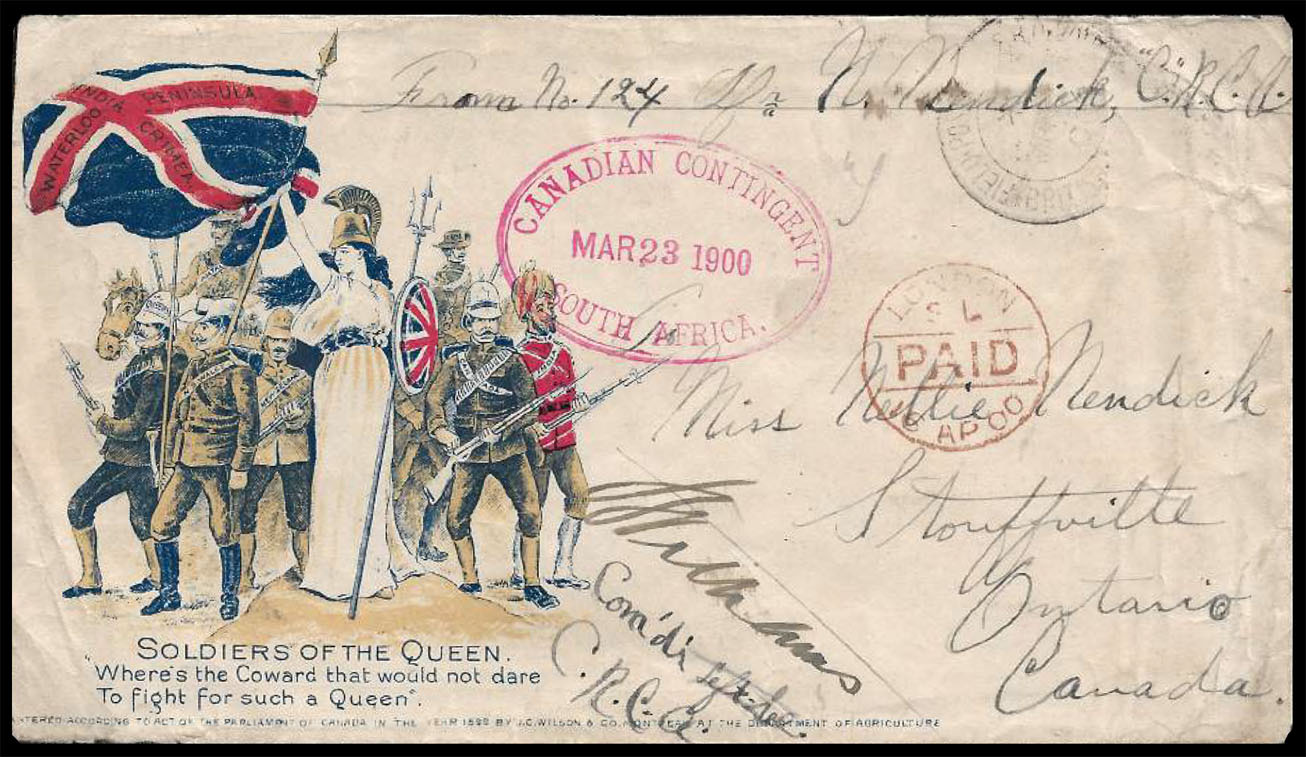
1900. Cover. CANADIAN CONTINGENT SOUTH AFRICA 'MAR 23 1900' to CANADA. (ex. Dr Franks.)
Canada's colonial status began with French cessions in 1763, leading to British North American provinces. In 1867, Confederation formed the Dominion of Canada, granting internal self-rule while foreign affairs remained under British control. The 1931 Statute of Westminster affirmed legislative independence. Full sovereignty came via the 1982 Constitution Act. Canada lost some 65,000 men in WW1.
India was initially exploited by the East India Company from the 1600s. After the 1857 Sepoy Mutiny it fell under direct Crown rule and was known as the British Raj. Indian troops played a significant role in both the First and Second World Wars. Millions of men from the Indian Army fought on various fronts including the Western Front, North Africa, the Middle East, and Southeast Asia, providing a massive fighting force and crucial supplies that were vital to Britain's war efforts. Nationalist movements culminated in independence and the partition of India and Pakistan in 1947. India became a republic in 1950, Pakistan in 1956. Both remained within the Commonwealth.
India (India and Pakistan) lost some 74,ooo men in WW1 and over 87,000 Indian troops in WW2. In both conflicts they served under the Union Jack. The difference between the two wars lay in the 1.5 to 3 million Indian civilians who died in World War II. The civilian death toll in India during World War II was largely the result of the Bengal Famine of 1943 and the strainsplaced on food supply and distribution caused by the war effort. Other contributing factors included bombing, relocation, civil unrest and disease

Australia 1908
A Blue Ensign defaced with the seven-point Commonwealth Star and Southern Cross in the fly half.
Still currently used as the national flag of Australia.
Australia's colonisation started with the 1788 penal settlement at Botany Bay, expanding into self-governing colonies. Federation in 1901 established it as a Dominion, with independence formalized in 1931.
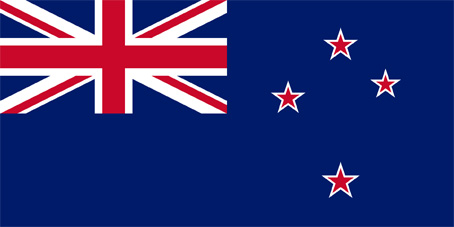
New Zealand 1902
A Blue Ensign with the Southern Cross of four white-edged red five-pointed stars in the fly half.
This flag is still currently used as the National flag of New Zealand.
New Zealand, annexed in 1840 via the Treaty of Waitangi, gained responsible government in 1852 and Dominion status in 1907, achieving full independence in 1947. Australia lost just over 62,000 men and New Zealand some 18,000 men in WW1.
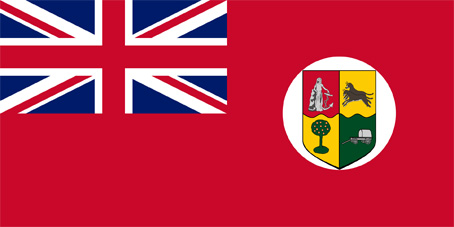
South Africa 1912
The design of the Red Ensign was modified slightly in 1912 when the shield was placed on a white disc.
The Red Ensign continued to be used as the flag of the South African merchant marine until 1951
South Africa's Cape Colony was seized twice, first in 1795 - 1803 and again in 1806 after which it was purchased for £6m as part of the London Convention. an agreement to resolve territorial disputes after Napoleon's defeat. Tensions between the British colonies, the Boer republics and Black South African tribes fueled numerous wars. In 1910 the conquered Boer states of the Orange Free State and South African Republiv (ZAR / Transvaal) joined together to create the Union of South Africa, a British Dominion that exluded Blacks politically. 'White South African' racial policies led to a republican status in 1961 and a temporary exit from Commonwealth until 1994. South Africa lost some 11,700 men of all races in WW1. Rhodesian sources indicate that 700 White settlers and a total of 873 people of all races died in the conflict.
These nations transitioned from imperial subjugation as colonies to full autonomy within the evolving Commonwealth, reflecting decolonisation amid global shifts in power and allegiances.
Quote from Steve on September 5, 2025, 3:43 pmThe Union of South Africa: 1910
1910. UNITED. Union is Strength.
1910. The Arms of the Union of South Africa.
1910. 4 November. Opening of the Union Parliament
1910. Enlargement of the Armorial Shield in the Opening of Parliament Stamp.
The Union of South Africa: 1910
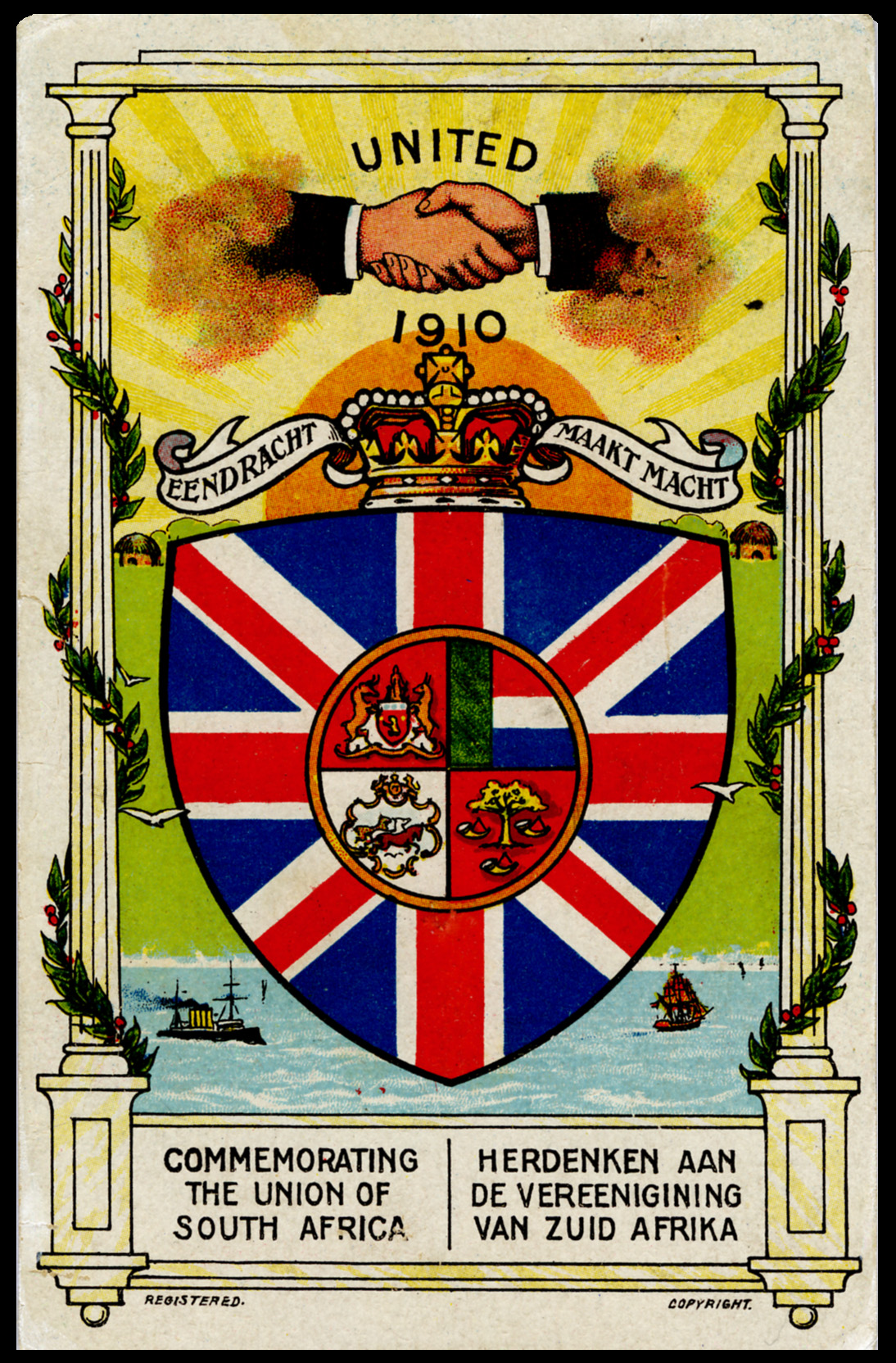
1910. UNITED. Union is Strength.
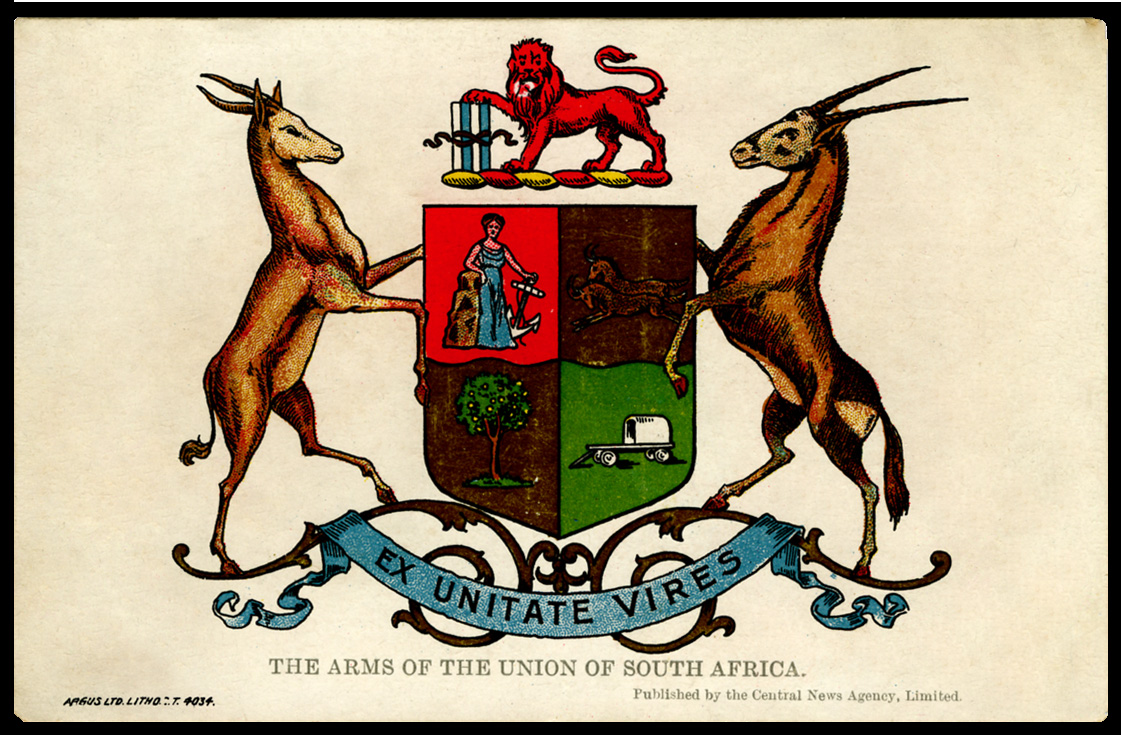
1910. The Arms of the Union of South Africa.
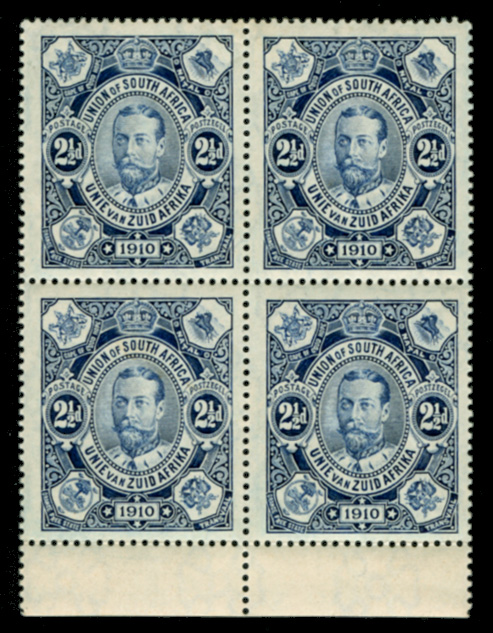
1910. 4 November. Opening of the Union Parliament
 1910. Enlargement of the Armorial Shield in the Opening of Parliament Stamp.
1910. Enlargement of the Armorial Shield in the Opening of Parliament Stamp.
Quote from Steve on September 17, 2025, 9:49 amHere is a privately produced postcard showing a 'Canadian' flag, the Union Jack. This has little to do with the Heraldry of South Africa and everything to do with Canadian history. I include it here because as you can see from Dr Frank's wonderful Canadian Contingent cover above the Canadians came to South Africa in support the British in their hostile take-over of the Boer republics.
Partly because of Canada's jingoistic support for the British Queen Empress and her Pink Empire many South Africans love to see the Springboks blooding Canadians on the rugby field today. It is our way of getting even. We particularly like beating the English. It is a pity the Canadians cannot play a better game, like the Australians and New Zealanders who also did their unthinking patriotic bit during the SAW (South African War), 1899 -1902.
Rugby was perhaps the one good thing that Britain gave to South Africa. What else did we get? Cricket, hockey and netball? Democracy? We like to smash the Red Roses of England in rugby and, truth be told, they like smash us up in equal measure but sadly not always in the spirit of the game. In the misconstrued immortal words of hooker Bongi Mbonambi, many South Africans view England as the mean and churlish cheating "wit kant" side of the game. Just so there is no question about this, England wear white in international matches. In Afrikaans Bongi's "wit kant" means "white side", not Tom Curry's unsporting, specious and tendentious claim of racist sexist abuse.
1908. Privately printed patriotic Canadian postcard.
"Entered according to Act of the of the Parliament of Canada in the Year 1908
by J. C. Wilson & Co. Montreal, at the Department of Agriculture."This is presumably part of the post-SAW Canadian remembrance of the SAW after the unveiling of a proper Memorial to the Canada's Glorious Dead on Victoria Day, 24th May 1907. (This was the day of Queen Victoria's birthday.) When the Montreal Monument was unveiled, Quebec’s chief justice said it would stand forever “to remind generations of the high hearted and fearless young fellows who sailed away to fight battles of the flag in another hemisphere, under other stars, and who still sleep there.”
This card above was published some five of six years after the SAW (aka Anglo-Boer War) ended in May 1902. It was presumably intended to keep the flame of memory alive for the approximately 274 Canadians who died in South Africa between 1899 and 1902. Today the Montreal Memorial for Canadians who died in South Africa is known as the Boer War Memorial, also as the South African Memorial. Located in Dorchester Square, Montreal, it was unveiled in 1907, some year or so before this card was published.
The majority of Candian deaths in South Africa during the war resulted from illness. Just 89 Canadian soldiers were killed in action. Some 26,000 Boer women, children and old men, as well as some 16,000 Black refugess died as a consequence of the scorched earth tactics of the British Army that the Canadians contingent participated in.
1907. Postcard. 'Strathcona and South African Soldiers Monument'.
Note: The term "Anglo-Boer War' was not used here. The term used is 'South African War'.
The term "Anglo-Boer War" developed in SA for racist political reasons.The sculpture is composed of a bucking horse statue and a soldier in distinct Lord Strathcona’s Horse uniform, dismounted and holding with his right hand the bridle of his horse. The statue was forged of bronze in Paris and is one and a half times life size. The grey-granite pedestal is adorned with four bronze bas-reliefs and numerous inscriptions. Three bas-reliefs depict battles in which Canadian soldiers stood out: Paardeberg, Komati River and Belfast. The fourth bas-relief depicts Lord Strathcona. It should be noted that Canadian artillerymen were present at the Siege of Mafeking where Baden-Powell greatly admired their uniforms. Had they not been there BP's Boy Scouts might never have worn Mountie-style hats. This was possibly Canada's greatest legacy in terms of its SAW contribution!
Here is a privately produced postcard showing a 'Canadian' flag, the Union Jack. This has little to do with the Heraldry of South Africa and everything to do with Canadian history. I include it here because as you can see from Dr Frank's wonderful Canadian Contingent cover above the Canadians came to South Africa in support the British in their hostile take-over of the Boer republics.
Partly because of Canada's jingoistic support for the British Queen Empress and her Pink Empire many South Africans love to see the Springboks blooding Canadians on the rugby field today. It is our way of getting even. We particularly like beating the English. It is a pity the Canadians cannot play a better game, like the Australians and New Zealanders who also did their unthinking patriotic bit during the SAW (South African War), 1899 -1902.
Rugby was perhaps the one good thing that Britain gave to South Africa. What else did we get? Cricket, hockey and netball? Democracy? We like to smash the Red Roses of England in rugby and, truth be told, they like smash us up in equal measure but sadly not always in the spirit of the game. In the misconstrued immortal words of hooker Bongi Mbonambi, many South Africans view England as the mean and churlish cheating "wit kant" side of the game. Just so there is no question about this, England wear white in international matches. In Afrikaans Bongi's "wit kant" means "white side", not Tom Curry's unsporting, specious and tendentious claim of racist sexist abuse.
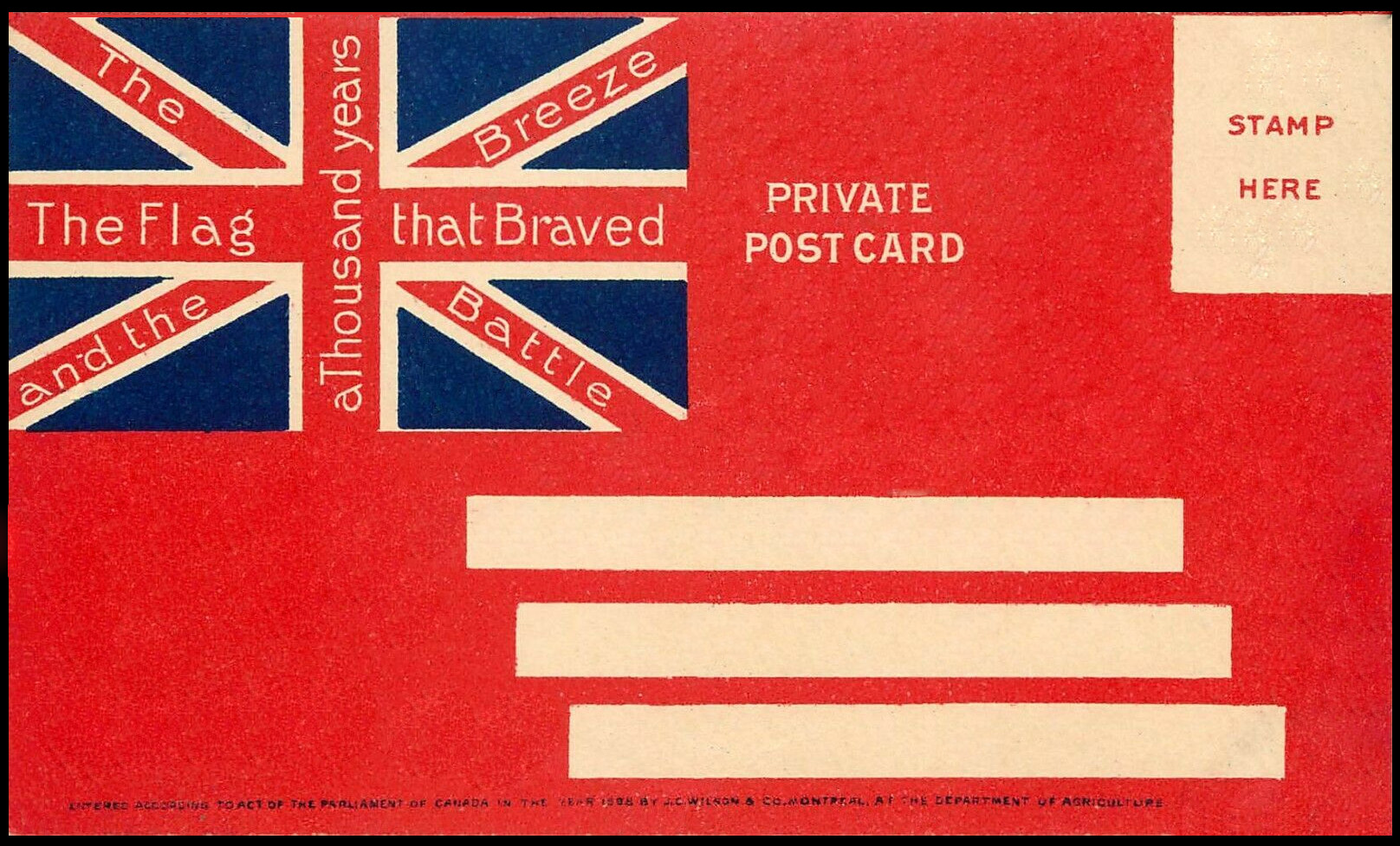
1908. Privately printed patriotic Canadian postcard.
"Entered according to Act of the of the Parliament of Canada in the Year 1908
by J. C. Wilson & Co. Montreal, at the Department of Agriculture."
This is presumably part of the post-SAW Canadian remembrance of the SAW after the unveiling of a proper Memorial to the Canada's Glorious Dead on Victoria Day, 24th May 1907. (This was the day of Queen Victoria's birthday.) When the Montreal Monument was unveiled, Quebec’s chief justice said it would stand forever “to remind generations of the high hearted and fearless young fellows who sailed away to fight battles of the flag in another hemisphere, under other stars, and who still sleep there.”
This card above was published some five of six years after the SAW (aka Anglo-Boer War) ended in May 1902. It was presumably intended to keep the flame of memory alive for the approximately 274 Canadians who died in South Africa between 1899 and 1902. Today the Montreal Memorial for Canadians who died in South Africa is known as the Boer War Memorial, also as the South African Memorial. Located in Dorchester Square, Montreal, it was unveiled in 1907, some year or so before this card was published.
The majority of Candian deaths in South Africa during the war resulted from illness. Just 89 Canadian soldiers were killed in action. Some 26,000 Boer women, children and old men, as well as some 16,000 Black refugess died as a consequence of the scorched earth tactics of the British Army that the Canadians contingent participated in.
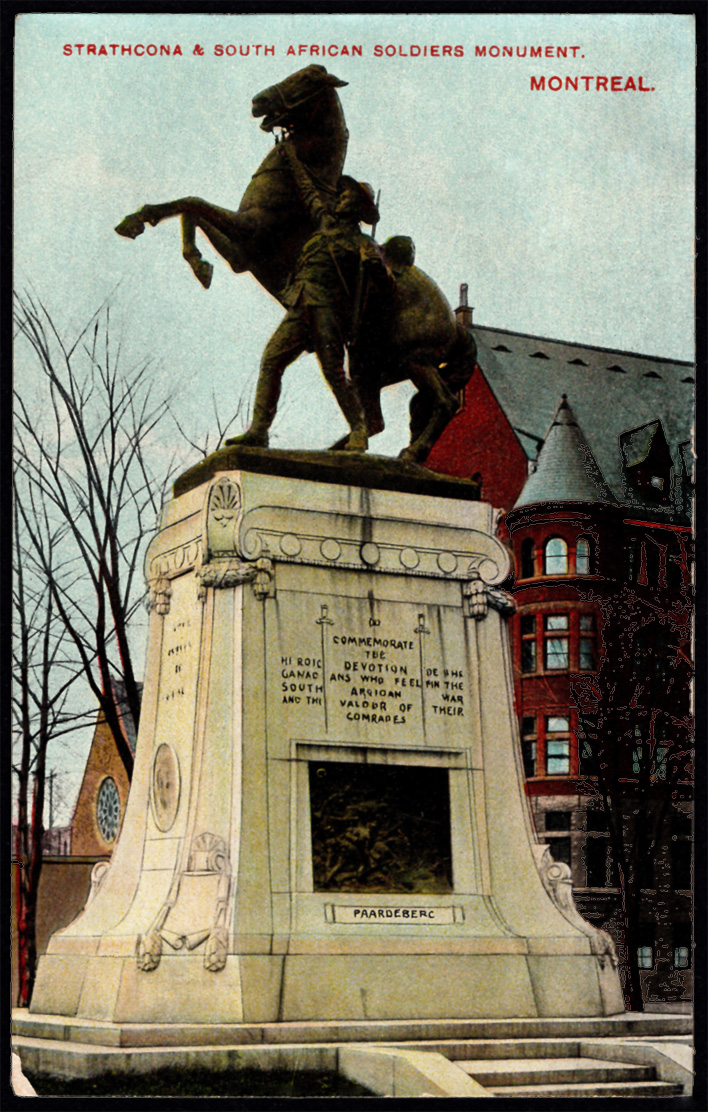
1907. Postcard. 'Strathcona and South African Soldiers Monument'.
Note: The term "Anglo-Boer War' was not used here. The term used is 'South African War'.
The term "Anglo-Boer War" developed in SA for racist political reasons.
The sculpture is composed of a bucking horse statue and a soldier in distinct Lord Strathcona’s Horse uniform, dismounted and holding with his right hand the bridle of his horse. The statue was forged of bronze in Paris and is one and a half times life size. The grey-granite pedestal is adorned with four bronze bas-reliefs and numerous inscriptions. Three bas-reliefs depict battles in which Canadian soldiers stood out: Paardeberg, Komati River and Belfast. The fourth bas-relief depicts Lord Strathcona. It should be noted that Canadian artillerymen were present at the Siege of Mafeking where Baden-Powell greatly admired their uniforms. Had they not been there BP's Boy Scouts might never have worn Mountie-style hats. This was possibly Canada's greatest legacy in terms of its SAW contribution!
Quote from Jamie Smith on September 17, 2025, 1:15 pmFirstly you say, that Queen Victoria, bithday was, '24th May 1907. (This was the day of Queen Victoria's birthday.)'. She was long dead by then!
Secondly you ask what Britain did for South Africa. I must say that when I lived there most of the roads, railways, mines, harbours, monuments were put it by the British or based on ideas from Britain. (The Scottish having been to the fore).
You refer to the Canadians as ??? but please remember many of our South African friends were welcomed there after everything was given away, and are now proud Canadians!
Lastly you talk about South Africans smashing the old teams on the rugby field but you say nothing of all the 'smashing' that modern South Africans have done to the infrastructure that the British helped to put in!
Firstly you say, that Queen Victoria, bithday was, '24th May 1907. (This was the day of Queen Victoria's birthday.)'. She was long dead by then!
Secondly you ask what Britain did for South Africa. I must say that when I lived there most of the roads, railways, mines, harbours, monuments were put it by the British or based on ideas from Britain. (The Scottish having been to the fore).
You refer to the Canadians as ??? but please remember many of our South African friends were welcomed there after everything was given away, and are now proud Canadians!
Lastly you talk about South Africans smashing the old teams on the rugby field but you say nothing of all the 'smashing' that modern South Africans have done to the infrastructure that the British helped to put in!
Quote from Steve on September 17, 2025, 6:03 pmIn answer to the points you make:
Firstly you say, that Queen Victoria, bithday was, '24th May 1907. (This was the day of Queen Victoria's birthday.)'. She was long dead by then!
The Montreal statue was unveiled on the anniversary of Queen Victoria's birthday, It was a testament to the love Canada had for their dead Queen and the Empire she had ruled over and for which they had fought and died. If nothing else, the unveiling of this monument on her birthday is proof of Canada's visceral ties to imperial loyalty.
Secondly you ask what Britain did for South Africa. I must say that when I lived there most of the were put it by the British or based on ideas from Britain. (The Scottish having been to the fore).
Britain ruled the Cape and Natal from 1806 to 1910 and during that time were responsible for maintaing and developing these colonies. Britain had two periods were it briefly ruled the OFS and ZAR (South African Republic, aka Transvaal). As this was before the discovery of gold, Britain had little incentive to spend British taxpayer's money on developing the ZAR's infrastructure. After Majuba, the ZAR was self-governing from 1881 until 1902. The British ruled the Transvaal from 1902 to 1910 whereupon the Union of SA was created. At this point South Africans took responsibility for management of the countr When the Boers trekked out of the Cape, the British did not build a road for them to do so. When diamonds were discovered the Cape Government, not the British, built the railways to Kimberley. In the absence of railways and proper roads, ox-wagons travelling across the veld supplied Kimberley in the first instance.
Circa 1900.Postcard. Map of the Boer Republics of OFS and ZAR (Transvaal) showing Flag and Regalia of State.
The railway line that was built by the Nederland ZAR Railway Co. runs from Lourenco Marques, PEA, to PretoriaWhen the British attempted to strong-arm the ZAR through their reliance on these railway lines, the ZAR with Dutch help built a railway line from PEA to Pretoria. The ZAR's freedom to not be reliant on 'British' railways was one big reason for the Jameson Raid. Yes, the mines were bui;lt by British and international capital under the guidance and control of the ZAR government, not the British. Post the South African War the 'roads, railways, mines, harbours, monuments' that were built were built by South Africans, not the British. Regarding the Scots, while they had great influence in some countries of the British Empire as administrators and teachers, notably Canada, they made less of a contribution in SA.
Circa 1898. President Paul Kruger of the ZAR wearing his Regalia showing State Arms.
The Second ZAR ran 'the Transvaal' from 1881 - 1900, twice as long as Britain, 1900 - 1910.You refer to the Canadians as ??? but please remember many of our South African friends were welcomed there after everything was given away, and are now proud Canadians!
Many South Africans, especially Coloured and Indian people, left SA in the Apartheid years to find refuge in Canada. Some of these people had lost their homes to the Group Areas Act. Today, after years of ANC corrupton, graft and theft, South Africans continue to go to Canada, as well as the USA, Australia, New Zealand, Ireland, the UK and France, the last three being especially welcoming to South African rugby players. Most top tier rugby teams feature South African expats. Regarding "proud Canadians", theirs is a liberal country now facing the very real prospect of separatism. As in many other Western countries, the policies of its political elite no longer reflect popular opinion. I sympathise with Canadians who are not responsible for the woke mess their leaders have got them into.
Lastly you talk about South Africans smashing the old teams on the rugby field but you say nothing of all the 'smashing' that modern South Africans have done to the infrastructure that the British helped to put in!
Smashing your oppnents is a contemporary rugby pharse said with relish by men bigger than me. I agree that the ANC have ruined the country. The ANC is no longer the guiding moral compass that we thought it was when Nelson Mandela walked free. It has fallen so short of any measure of decency, accountability and responsibilty that is now largely a self-sustaining cabal of gangsters, political tsotsis.
I have tried to express how I feel about the ANC in my Obituary of Neil de Beer.
I disagree that the British people put the infrastructure in. Sure, we were a part of its Empire but the Union under Botha, Smuts and Hertzog and later the Republic of South Africa under the Nationalists paid the Lion's share of the bills. (Yes, Britain did build Simonstown Naval Base to the tune of £200m in the then Cape Colony but that was for its own global strategic interests, not for South Africa's). What Britain did in South Africa was make the country accessible to international capital. This created jobs, mostly for Black people. The triumph of capitalism re-invented the country as a modern industrial state. The narrow-minded socialism of the Boers, something that persisted with Apartheid, was discarded. It was capital, not Britain that created the modern South Africa. It is now the idealist ANC with their socialist liberation ideology and criminality that is "smashing" South Africa's potential for growth and prosperity.
I agree with your comment about the "infrastructure that the British helped to put in!" A lot of embittered White folk used to talk about how "we built South Africa", ignoring the fact that it was Black workers who laboured away carrying the bricks and digging away at the pit face, etc., of every new development. Finally, as you know, South Africa won WW2 for Britain through its shipments of gold to the USA to pay for Lend Lease. In this regard, South African gold was more vital to British interests than the people of South Africa.
In answer to the points you make:
Firstly you say, that Queen Victoria, bithday was, '24th May 1907. (This was the day of Queen Victoria's birthday.)'. She was long dead by then!
The Montreal statue was unveiled on the anniversary of Queen Victoria's birthday, It was a testament to the love Canada had for their dead Queen and the Empire she had ruled over and for which they had fought and died. If nothing else, the unveiling of this monument on her birthday is proof of Canada's visceral ties to imperial loyalty.
Secondly you ask what Britain did for South Africa. I must say that when I lived there most of the were put it by the British or based on ideas from Britain. (The Scottish having been to the fore).
Britain ruled the Cape and Natal from 1806 to 1910 and during that time were responsible for maintaing and developing these colonies. Britain had two periods were it briefly ruled the OFS and ZAR (South African Republic, aka Transvaal). As this was before the discovery of gold, Britain had little incentive to spend British taxpayer's money on developing the ZAR's infrastructure. After Majuba, the ZAR was self-governing from 1881 until 1902. The British ruled the Transvaal from 1902 to 1910 whereupon the Union of SA was created. At this point South Africans took responsibility for management of the countr When the Boers trekked out of the Cape, the British did not build a road for them to do so. When diamonds were discovered the Cape Government, not the British, built the railways to Kimberley. In the absence of railways and proper roads, ox-wagons travelling across the veld supplied Kimberley in the first instance.
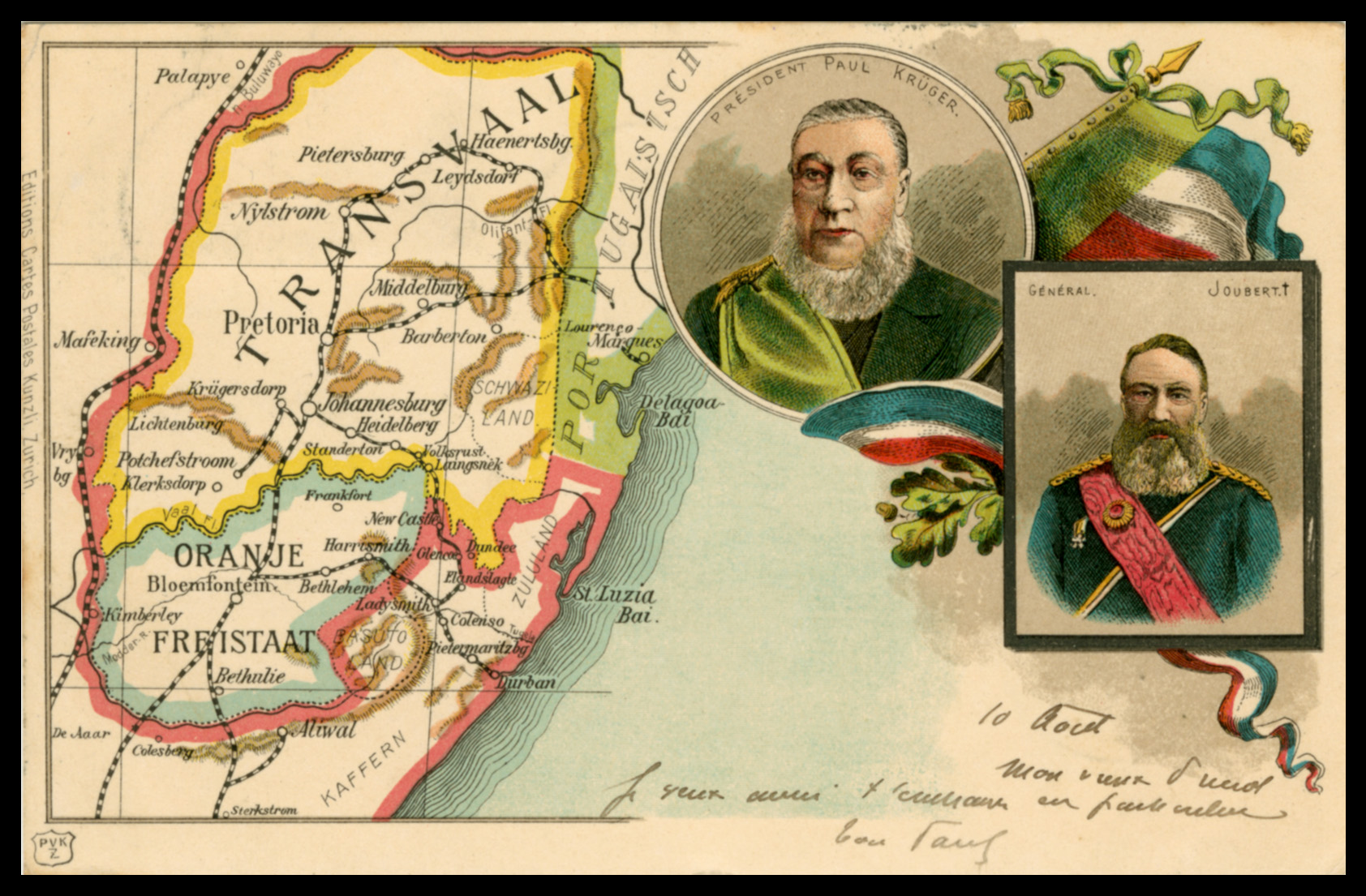
Circa 1900.Postcard. Map of the Boer Republics of OFS and ZAR (Transvaal) showing Flag and Regalia of State.
The railway line that was built by the Nederland ZAR Railway Co. runs from Lourenco Marques, PEA, to Pretoria
When the British attempted to strong-arm the ZAR through their reliance on these railway lines, the ZAR with Dutch help built a railway line from PEA to Pretoria. The ZAR's freedom to not be reliant on 'British' railways was one big reason for the Jameson Raid. Yes, the mines were bui;lt by British and international capital under the guidance and control of the ZAR government, not the British. Post the South African War the 'roads, railways, mines, harbours, monuments' that were built were built by South Africans, not the British. Regarding the Scots, while they had great influence in some countries of the British Empire as administrators and teachers, notably Canada, they made less of a contribution in SA.
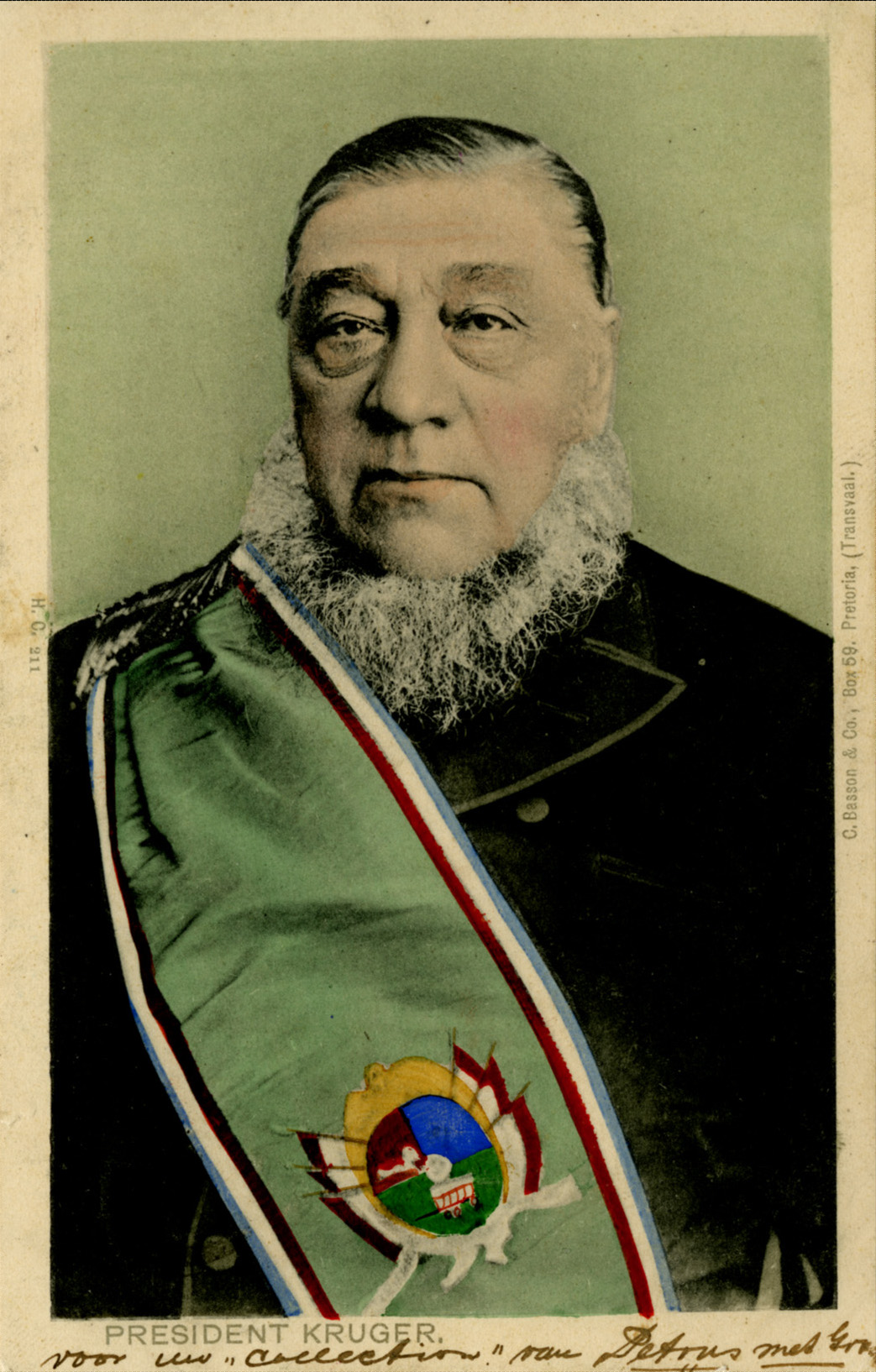
Circa 1898. President Paul Kruger of the ZAR wearing his Regalia showing State Arms.
The Second ZAR ran 'the Transvaal' from 1881 - 1900, twice as long as Britain, 1900 - 1910.
You refer to the Canadians as ??? but please remember many of our South African friends were welcomed there after everything was given away, and are now proud Canadians!
Many South Africans, especially Coloured and Indian people, left SA in the Apartheid years to find refuge in Canada. Some of these people had lost their homes to the Group Areas Act. Today, after years of ANC corrupton, graft and theft, South Africans continue to go to Canada, as well as the USA, Australia, New Zealand, Ireland, the UK and France, the last three being especially welcoming to South African rugby players. Most top tier rugby teams feature South African expats. Regarding "proud Canadians", theirs is a liberal country now facing the very real prospect of separatism. As in many other Western countries, the policies of its political elite no longer reflect popular opinion. I sympathise with Canadians who are not responsible for the woke mess their leaders have got them into.
Lastly you talk about South Africans smashing the old teams on the rugby field but you say nothing of all the 'smashing' that modern South Africans have done to the infrastructure that the British helped to put in!
Smashing your oppnents is a contemporary rugby pharse said with relish by men bigger than me. I agree that the ANC have ruined the country. The ANC is no longer the guiding moral compass that we thought it was when Nelson Mandela walked free. It has fallen so short of any measure of decency, accountability and responsibilty that is now largely a self-sustaining cabal of gangsters, political tsotsis.
I have tried to express how I feel about the ANC in my Obituary of Neil de Beer.
I disagree that the British people put the infrastructure in. Sure, we were a part of its Empire but the Union under Botha, Smuts and Hertzog and later the Republic of South Africa under the Nationalists paid the Lion's share of the bills. (Yes, Britain did build Simonstown Naval Base to the tune of £200m in the then Cape Colony but that was for its own global strategic interests, not for South Africa's). What Britain did in South Africa was make the country accessible to international capital. This created jobs, mostly for Black people. The triumph of capitalism re-invented the country as a modern industrial state. The narrow-minded socialism of the Boers, something that persisted with Apartheid, was discarded. It was capital, not Britain that created the modern South Africa. It is now the idealist ANC with their socialist liberation ideology and criminality that is "smashing" South Africa's potential for growth and prosperity.
I agree with your comment about the "infrastructure that the British helped to put in!" A lot of embittered White folk used to talk about how "we built South Africa", ignoring the fact that it was Black workers who laboured away carrying the bricks and digging away at the pit face, etc., of every new development. Finally, as you know, South Africa won WW2 for Britain through its shipments of gold to the USA to pay for Lend Lease. In this regard, South African gold was more vital to British interests than the people of South Africa.
Quote from Steve on September 20, 2025, 10:23 amThe Theatre of War
This interesting 6d A4 landscape publication below was written in early 1900 when Ladysmith, Kimberley and Mafeking were still besieged. The war was not going well for Britain at this time and it would not be long before the British Army in South Africa had a new commander, Lord Roberts, who is not directly mentioned nor pictured here. Churchill is pictured and described as "now in Pretoria" ie. a POW at the time this publication was written, his escape not yet being known. Modder River is "Methuen's great fight".
Its front cover shows the Republican General Joubert and the Imperialist General Sir Redvers Buller, the two opposing commanders. and the flags of the combatants with the Union Jack dominant. The publication is entitled 'The Theatre of War' and is clearly intended to educate its readers in about the conflict and its causes with a strong bias towards the virtuous and gentlemanly British cause.
1900. Illustrated Publication. 68 pages.'The Theatre of War'.
Imperialism at work - "Australia Canada. Under One Flag. Unity, Peace, Prosperity."
Note the flags of the Orange Free State, left, and the ZAR (Transvaal), right.This publication was produced for the refined lady readers of 'The Gentlewoman' magazine. It includes many portait photographs of the equally refined young officers of the upper classes who have been killed or wounded in action. As such it is a useful source of images, some unusual, that show people and places relevant to postal history displays. It has an erroneous report of General Ben Vilkjoen's death at Elandslaagte. Apparently, the Boers have "primitive ideas of comfort and cleanliness .... and frequently sleep in their clothes".
What is notable about this British publication is that nowhere does it refer to an 'Anglo-Boer War'. That phrae will only be invented later in the war. The Zulu War of 1879 and the Boer War of 1881 are mentioned but this conflict seems not to have gained a name at this time in this publication other than a reference to the "campaign in South Africa". However by late 1901 some in South Africa had begun to use the term 'Anglo-Boer War'. The postcard below is the earliest example I have found of South African use of 'Anglo-Boer War'.
1901. Postcard.Unused. 'Anglo-Boer War 1899 - 1901'. Commemorative Postcard. Rule Brittania!
Note the "Flag and Arms of the Late South African Republic".
Circa 1900. Arms of Country Label.
Spot the Error in this ZAR Coat of Arms.This label was previously used to add the arms of the ZAR to a stamp album. The green panel is missing from this representation of the ZAR 'Vierkleur' (Afr. Four Colour) flag. The above flag is identical to the national flag of the Netherlands which uses a horizontal tricolour of red, white, and blue. The current Dutch flag is a variant of the late 16th century orange, white and blue 'Prinsenvlag' (Dutch. Prince's Flag), When Holland became a Republic the orange of the royal House of Orange was replaced with red. The Dutch flag is the oldest tricolour flag in continuous use. The Vierkleur is no longer used in South Africa but its colours of red, white and blue, also the colours of Britain's Union Jack, are found in the new South African flag, facetiously known as 'Nelson Mandela's Underpants'.
1857 - 1902 with gaps. The ZAR Vierkleur, the national flag of the South African Republic (Transvaal),
The ZAR used the 'Vierkleur' from 1857 to 1874, the so-called 'Burger Flag' from 1874 to 1875. and the Vierkleur again from 1875 to 1877 and 1881 to 1902. Between 1877 - 1881 the ZAR was under British admnistration and used the British Union Jack. After Majuba and the start of the Second Republic it used the Vierkleur. After the Repblicans were defeated in the SAW the British Transvaal Colony initially reverted to using the Union Jack, During the Republican Rebellion at the start of WW1 the Vierkleur was used by the 'Maritz Rebels' who had declared a new South African Republic in 1914. This lasted until the Rebellion was crushed in February 1915.
I will cover the Blue Ensign flags of the Transvaal Colony 1902 - 1910 another time.
1994. 'Nelson Mandela's Underpants'.
Adopted on 27th April 1994, South Africa introduced a new flag that symbolises the country's transition to democracy. It incorporates elements from previous flags and the African National Congress (ANC) banner. Designed by State Herald Fred Brownell, it features a black, gold, green, red, white and blue design in which the black, green, and gold colours represent the ANC and the red, white and blue maintain continuity with historic Dutch and British flags. The distinctive Y-shaped band signifies the convergence and unification of diverse peoples within South Africa. This Y-front shape and Madiba's love of the colourful and exotic as expressed in his shirts has resulted in it being called Nelson Mandela's Underpants'. The flag has won broad approval and is now undoubtedly the symbol of the new South Africa.
The Theatre of War
This interesting 6d A4 landscape publication below was written in early 1900 when Ladysmith, Kimberley and Mafeking were still besieged. The war was not going well for Britain at this time and it would not be long before the British Army in South Africa had a new commander, Lord Roberts, who is not directly mentioned nor pictured here. Churchill is pictured and described as "now in Pretoria" ie. a POW at the time this publication was written, his escape not yet being known. Modder River is "Methuen's great fight".
Its front cover shows the Republican General Joubert and the Imperialist General Sir Redvers Buller, the two opposing commanders. and the flags of the combatants with the Union Jack dominant. The publication is entitled 'The Theatre of War' and is clearly intended to educate its readers in about the conflict and its causes with a strong bias towards the virtuous and gentlemanly British cause.

1900. Illustrated Publication. 68 pages.'The Theatre of War'.
Imperialism at work - "Australia Canada. Under One Flag. Unity, Peace, Prosperity."
Note the flags of the Orange Free State, left, and the ZAR (Transvaal), right.
This publication was produced for the refined lady readers of 'The Gentlewoman' magazine. It includes many portait photographs of the equally refined young officers of the upper classes who have been killed or wounded in action. As such it is a useful source of images, some unusual, that show people and places relevant to postal history displays. It has an erroneous report of General Ben Vilkjoen's death at Elandslaagte. Apparently, the Boers have "primitive ideas of comfort and cleanliness .... and frequently sleep in their clothes".
What is notable about this British publication is that nowhere does it refer to an 'Anglo-Boer War'. That phrae will only be invented later in the war. The Zulu War of 1879 and the Boer War of 1881 are mentioned but this conflict seems not to have gained a name at this time in this publication other than a reference to the "campaign in South Africa". However by late 1901 some in South Africa had begun to use the term 'Anglo-Boer War'. The postcard below is the earliest example I have found of South African use of 'Anglo-Boer War'.
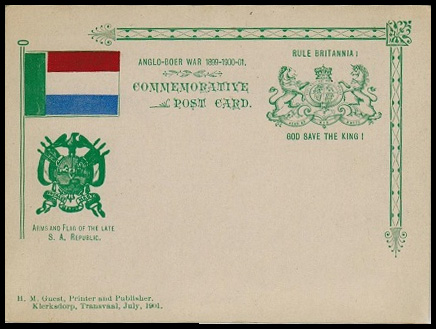
1901. Postcard.Unused. 'Anglo-Boer War 1899 - 1901'. Commemorative Postcard. Rule Brittania!
Note the "Flag and Arms of the Late South African Republic".
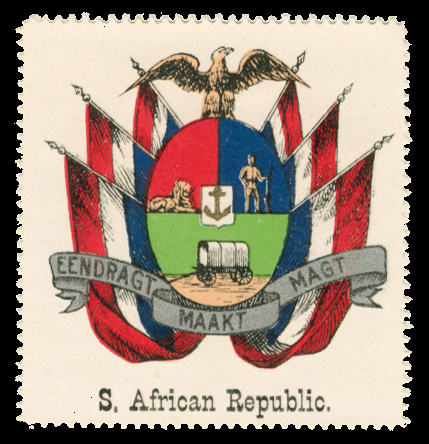
Circa 1900. Arms of Country Label.
Spot the Error in this ZAR Coat of Arms.
This label was previously used to add the arms of the ZAR to a stamp album. The green panel is missing from this representation of the ZAR 'Vierkleur' (Afr. Four Colour) flag. The above flag is identical to the national flag of the Netherlands which uses a horizontal tricolour of red, white, and blue. The current Dutch flag is a variant of the late 16th century orange, white and blue 'Prinsenvlag' (Dutch. Prince's Flag), When Holland became a Republic the orange of the royal House of Orange was replaced with red. The Dutch flag is the oldest tricolour flag in continuous use. The Vierkleur is no longer used in South Africa but its colours of red, white and blue, also the colours of Britain's Union Jack, are found in the new South African flag, facetiously known as 'Nelson Mandela's Underpants'.
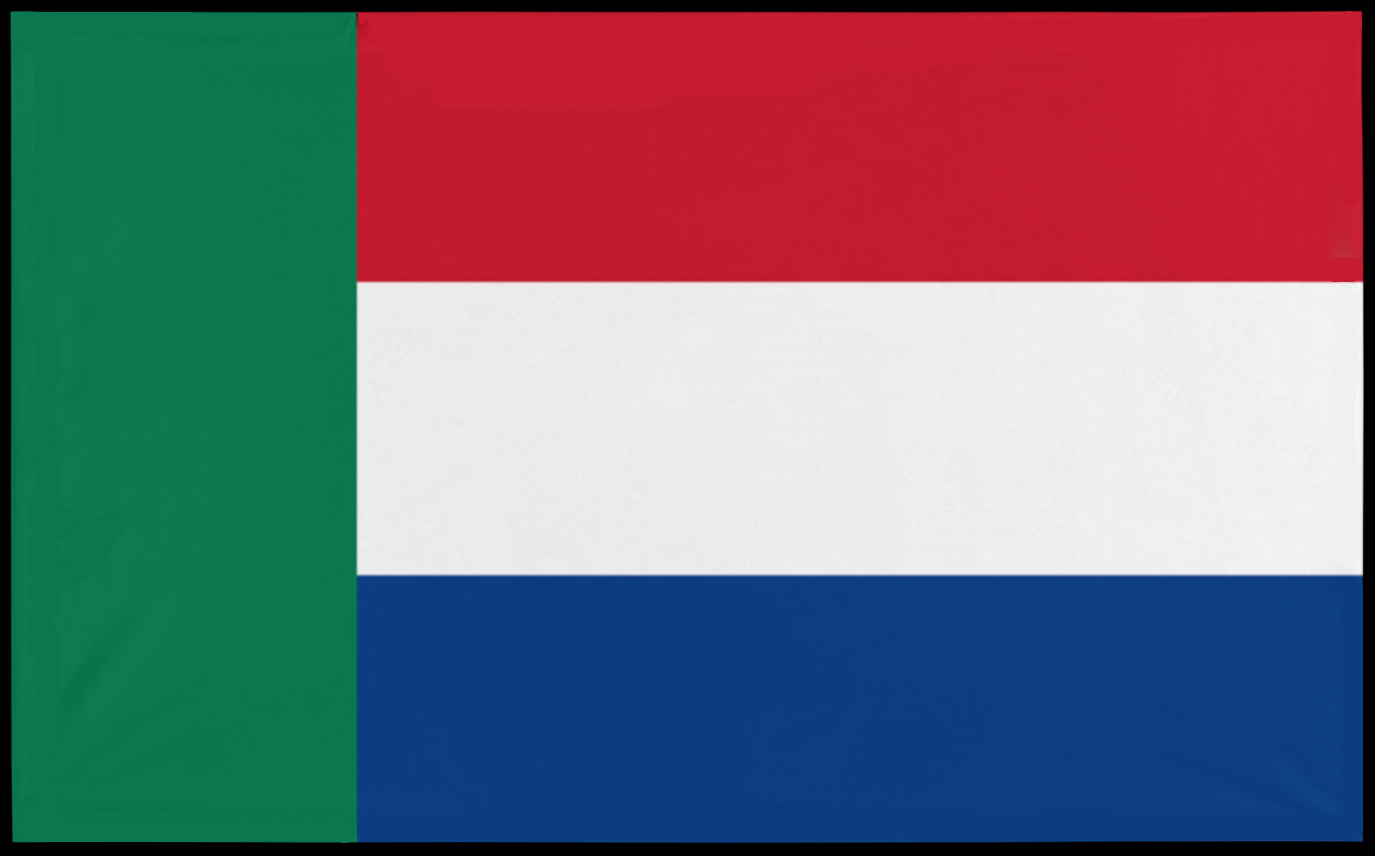
1857 - 1902 with gaps. The ZAR Vierkleur, the national flag of the South African Republic (Transvaal),
The ZAR used the 'Vierkleur' from 1857 to 1874, the so-called 'Burger Flag' from 1874 to 1875. and the Vierkleur again from 1875 to 1877 and 1881 to 1902. Between 1877 - 1881 the ZAR was under British admnistration and used the British Union Jack. After Majuba and the start of the Second Republic it used the Vierkleur. After the Repblicans were defeated in the SAW the British Transvaal Colony initially reverted to using the Union Jack, During the Republican Rebellion at the start of WW1 the Vierkleur was used by the 'Maritz Rebels' who had declared a new South African Republic in 1914. This lasted until the Rebellion was crushed in February 1915.
I will cover the Blue Ensign flags of the Transvaal Colony 1902 - 1910 another time.
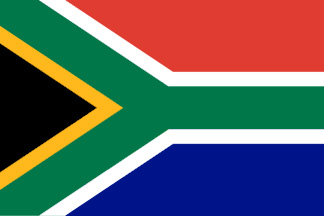
1994. 'Nelson Mandela's Underpants'.
Adopted on 27th April 1994, South Africa introduced a new flag that symbolises the country's transition to democracy. It incorporates elements from previous flags and the African National Congress (ANC) banner. Designed by State Herald Fred Brownell, it features a black, gold, green, red, white and blue design in which the black, green, and gold colours represent the ANC and the red, white and blue maintain continuity with historic Dutch and British flags. The distinctive Y-shaped band signifies the convergence and unification of diverse peoples within South Africa. This Y-front shape and Madiba's love of the colourful and exotic as expressed in his shirts has resulted in it being called Nelson Mandela's Underpants'. The flag has won broad approval and is now undoubtedly the symbol of the new South Africa.
Quote from Jamie Smith on September 20, 2025, 2:53 pm'Nelson Mandela's Underpants'. - Something to do with which one running the country is behind the Y front!
'Nelson Mandela's Underpants'. - Something to do with which one running the country is behind the Y front!
